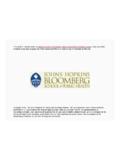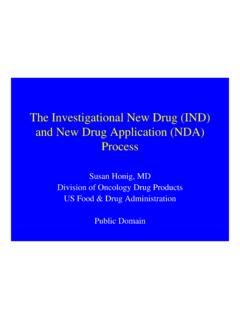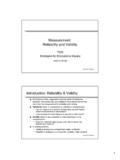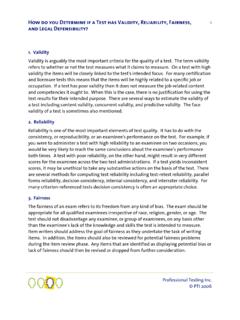Transcription of This work is licensed under a Creative Commons …
1 Copyright 2008, The Johns Hopkins University and Sukon Kanchanaraksa. All rights reserved. Use of these materials permitted only in accordance with license rights granted. Materials provided AS IS ; no representations or warranties provided. User assumes all responsibility for use, and all liability related thereto, and must independently review all materials for accuracy and efficacy. May contain materials owned by others. User is responsible for obtaining permissions for use from third parties as work is licensed under a Creative Commons Attribution-NonCommercial-ShareAlike License.
2 Your use of this material constitutes acceptance of that license and the conditions of use of materials on this of Diagnostic and Screening Tests: validity and ReliabilitySukon Kanchanaraksa, PhDJohns Hopkins UniversitySection ASensitivity and Specificity4 Correctly Classifying Individuals by Disease Status Tests are used in medical diagnosis, screening, and research How well is a subject classified into disease or non-disease group? Ideally, all subjects who have the disease should be classified as having the disease and vice versa Practically, the ability to classify individuals into the correct disease status depends on the accuracy of the tests.
3 Among other things5 Diagnostic Test and Screening Test A diagnostic testis used to determine the presence or absence of a disease when a subject shows signs or symptoms of the disease A screening testidentifies asymptomatic individuals who may have the disease The diagnostic test is performed aftera positive screening test to establish a definitive diagnosis6 Some Common Screening Tests Pap smear for cervical dysplasia or cervical cancer Fasting blood cholesterol for heart disease Fasting blood sugar for diabetes Blood pressure for hypertension Mammography for breast cancer PSA test for prostate cancer Fecal occult blood for colon cancer Ocular pressure for glaucoma PKU test for phenolketonuria in newborns TSH for hypothyroid and hyperthyroid7 Variation in Biologic Values Many test results have a continuous scale (are continuous variables) Distribution of biologic measurements in humans may or may not permit easy separation of diseased from non-diseased individuals, based upon the value of the measurement8 Number of subjects051015202539152127 Diameter of induration (mm)
4 Distribution of Tuberculin ReactionsSource: Edwards et al, WHO Monograph 12, 19539 Number of men0510152025809010011012013014015016017 0180190200 Systolic blood pressure in mm of mercurySource: Data of HollandDistribution of Systolic Blood Pressures: 744 Employed White Males, Ages 40 6410 validity Validityis the ability of a test to indicate which individuals have the disease and which do not11 Sensitivity and Specificity Sensitivity The ability of the test to identify correctly those who have the disease Specificity The ability of the test to identify correctly those who do not have the disease12 Determining the Sensitivity.
5 Specificity of a New Test Must know the correct disease status prior to calculation Gold standard testis the best test available It is often invasive or expensive Anew testis, for example, a new screening test or a less expensive diagnostic test Use a 2 x 2 table to compare the performance of the new test to the gold standard test13 DiseaseGold Standard Test+ a+c(All people with disease)b+d(All people without disease)14 DiseaseNew test(True positives)(True negatives)Comparison of Disease Status: Gold Standard Test and New Test+ +ab cd15 Sensitivityis the ability of the test to identify correctly those who have the disease (a) from all individuals with the disease (a+c) Sensitivity is a fixed characteristic of the test sensitivity=aa+c=true positivesdisease+=Pr(T+|D+)Sensitivity16 Specificityis the ability of the test to identify correctly those who do not have the disease (d) from all individuals free from the disease (b+d) Specificity is also a fixed characteristic of the testSpecificity sensitivity=db+d=true negativesdisease =Pr(T |D )
6 17 True Characteristics in Population Screening Results Disease No Disease Total Positive 80 100 180 Negative 20 800 820 Total 100 900 1,000 Applying Concept of Sensitivity and Specificity to a Screening Test Assume a population of 1.
7 000 people 100 have a disease 900 do not have the disease A screening test is used to identify the 100 people with the disease The results of the screening appears in this table18 Calculating Sensitivity and Specificity True Characteristics in Population Screening Results Disease No Disease Total Positive 80 100 180 Negative 20 800 820 Total 100 900 1.
8 000 Sensitivity = Specificity = 800/900 = 89%80/100 = 80%19 True Characteristics in Population Screening Results Disease No Disease Total Positive 80 100 180 Negative 20 800 820 Total 100 900 1,000 Evaluating ValiditySensitivity = 80/100 = 80%Specificity = 800/900 = 89%20 Examining the Effect of Changing Cut-Points Example.
9 Type II diabetes mellitus Highly prevalent in the older, especially obese, population Diagnosis requires oral glucose tolerance test Subjects drink a glucose solution, and blood is drawn at intervals for measurement of glucose Screening test is fasting plasma glucoseXEasier, faster, more convenient, and less sugarLowHigh20 diabetics 20 non-diabetics 20 diabetics 20 non-diabeticsDiabeticsNon-diabeticsConce pt of Sensitivity and Specificity22 Subjects are screened using fasting plasma glucose with a low (blood sugar) cut- point Subjects are screened using fasting plasma glucose with a low (blood sugar)
10 Cut- pointBlood sugarLowHighDiabeticsNon-diabeticsConcep t of Sensitivity and Specificity DiabeticsNon-Diabetics+1714 362020 Sens=85%Spec=30%23 Subjects are screened using fasting plasma glucose with a high cut-point Subjects are screened using fasting plasma glucose with a high cut-pointBlood sugarLowHighDiabeticsNon-diabeticsConcep t of Sensitivity and Specificity Diabetics Non-Diabetics+ 5 2 15 18 20 20 Sens=25% Spec=90% 24In a typical population, there is no line separating the two groups, and the subjects are mixed In a typical population, there is no line separating the two groups, and the subjects are mixedBlood sugarLowHighDiabeticsNon-diabeticsConcep t of Sensitivity and Specificity25In a typical population, there is no line separating the two groups, and the subjects are mixed In a typical population, there is no line separating the two groups, and the subjects are mixedBlood sugarLowHighDiabeticsNon-diabeticsConcep t of Sensitivity and Specificity26In fact, there is no color or label In fact.















